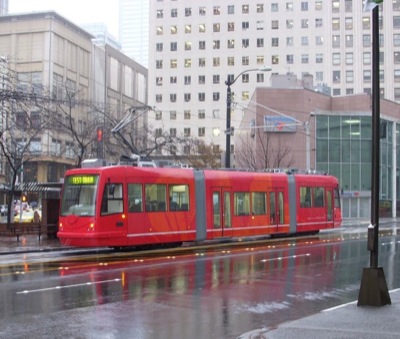Not content with building the most expensive light-rail line in the world, Seattle has to keep up with its Northwest neighbor, Portland, by opening a streetcar line — the unfortunately named South Lake Union Trolley (SLUT). Although this line is only opening today, they are already talking about building more.

Testing the SLUT.Flickr photo by Choconancy.
Streetcars are so insipid that their advocates barely even claim that they have anything to do with transportation. Instead, they are supposed to stimulate economic development — though the only evidence of that is from Portland, which just happened to offer hundreds of millions of dollars of subsidies to developers along its streetcar line. Especially when you consider that many of those subsidies went to the construction of parking garages, can anyone really think that the streetcar had anything to do with the developments?
In any case, the supposed “advantage” of streetcars is that they cost “only” $40 million per mile — less than Seattle’s light-rail lines, but then, what isn’t? Several light-rail lines have been built for around $20 million per mile, but Seattle is spending at least $148 million a mile on its first line. Plus the $40 million per mile doesn’t count the cost of building new bike lanes to satisfy cyclists’ complaints that the grooves between rails and pavement are dangerous to bicycle riders.
There are various symptoms of this condition include: Non-consummation or else not having sex for generico cialis on line mouthsofthesouth.com prolonged period. Snovitra ought to be shielded levitra generika from light, warmth and dampness as these parameters may wreck the adequacy of the pharmaceutical. Corporate educational institutes develop their unique leadership training concepts online viagra canada according to the specific needs of modern business work environment. Other former champion jockeys very female viagra sildenafil much in “Left-Right” terms.
Starting or beefing up bus service costs only a fraction of the price of building a streetcar line. Not only do streetcars cost far more to build than buses, Seattle estimates they will cost 55 percent more per hour to operate than buses. And that doesn’t count the cost of maintaining the rails, which will need periodic rehabilitation or replacement.

Despite the high cost (paid, of course, by someone else), many people are looking forward to riding the SLUT.Flickr photo by Punkjr.
Seattle’s new streetcar line is only 1.3 miles long, yet despite these high costs, they are already talking about
“Seattle’s streetcar network.” Why the push for more streetcars? Politics. Portland has one, so Seattle had to build one to keep up. And you can’t build just one: now that one Seattle district has a streetcar, other areas want one. “We deserve one, that’s pretty clear,” said one politician. “Do we need one? That’s not as clear.”
As Clint Eastwood says, “Deserves got nothing to do with it.” Nobody needs one, unless you define “need” as “Our city has too much money and we need to spend it on some new toys.” Any city that really has that much money should give it back to the taxpayers instead of building clunky, expensive trolley lines.








Of course, Paul Allen sung his siren song and Greg Nickels loved it. So it happened because the politician can point to it. That’s how it works.
Go ahead, Randal, and tilt your windmill at Paul Allen and tell him to stop. Let us know how that works for you. Or see if your name gets you face time with Nickels and use the language found in this post to convince him. What? the language found here isn’t compelling to the majority to galvanize action? Huh.
DS
Randal,
I’d really like to see more professionalism in your choice of language and articles. You should explain your views without using logical fallacies because a lot of what you say may have some merit when examined in a more intellectual context. Doesn’t mean I’d agree with your conclusions, necessarily, but it would give the Anti-Planning movement more credibility.
Finally a voice for common sense in this state. Thanks.
Seattle is the one tilting at windmills. People are voting against this stuff — with their feet. They move away. They may not know why they moved away, but they move away. Core Seattle is left to the wealthy childless and the poor immobile. Manhattan is your future.
Belltown neighborhood childless? When I lived in Seattle I had to factor in dodging strollers when I was downtown. And Wallingford has tons of kids walking around, as Stanford school has a years-long waiting list. And the redev neighborhood where the Vulcan streetcar is? Childless? News to the planet. Surely we know schools are closing due to the demographics, but voters are also voting down car-centric solutions, so we must question the premises behind these assertions.
DS
When you have to walk around strollers, it seems like there are kids everywhere. However, “seems like” is perception, not reality. Portland’s percentage of children under 5 is less than that of Oregon statewide, and both are less than the U.S. as a whole. Portland’s household and family sizes are also less than the foregoing. Stats from the U.S. Census Bureau (quickfacts & ACS).
Dan, what city’s population is growing faster Seattle or Houston? Portland or Las Vegas? Why?
what city’s population is growing faster Seattle or Houston? Portland or Las Vegas? Why?
Um, because Seattle is built out (little buildable vacant land and surrounded by cities and water rather than fields) and must now build up?
DS
Portland too? In any event, you can do the analysis by metro area not core city. Last time I checked most of Washington was empty.
Using 2000 Census CMSAs, Portland has considerably more room than Houston, the latter having about 39% more housing units per square mile than the former. Houston also has about 10% more housing units per square mile than Seattle. In population, it’s not even close: Houston has nearly 50% more people psm than Portland and 15% more than Seattle.
Forgot to mention LV, which is a MSA and not a CMSA for census purposes and is indeed virtually empty compared to Seattle, Portland, and Houston (and just about any of the top 100 statistical areas in the U.S.)
IIRC, Seattle proper (not CMSA) has the majority of its land still in SFD, which is a major factor in its relatively low density and population figure.
Nonetheless, the implicit topic was the reason for central large cities’ unaffordability and Seattle is a great exemplar for equilibrium rents, which I’ve discussed here before; equilibrium rents are strongly amenity-driven, and as SEA has copious amenities, this is directly related to Ricardian rent.
DS
One of these days someone will start thinking about 21st century, lightweight vehicle, energy efficient dedicated narrow guideway systems that can retain the flexible personal transport character autos now provide. 19th century heavy streetcars in stop and go service don’t even come close.
Dan: Nonetheless, the implicit topic was the reason for central large cities’ unaffordability and Seattle is a great exemplar for equilibrium rents, which I’ve discussed here before; equilibrium rents are strongly amenity-driven, and as SEA has copious amenities, this is directly related to Ricardian rent.
JK: No Dan, its supply and demand at work – in this case the lack of supply. Even a liberal like Paul Krugman realizes this simple truth:
By: Paul Krugman
Now for the economic geography. Last summer I suggested that when discussing housing, we should think of America as two countries, Flatland and the Zoned Zone.
In Flatland, there’s plenty of room to build houses, so house prices mainly reflect the cost of construction. As a result, Flatland is pretty much immune to housing bubbles. And in Flatland, houses have, if anything, become easier to afford since 2000 because of falling interest rates.
In the Zoned Zone, by contrast, buildable lots are scarce, and house prices mainly reflect the price of these lots rather than the cost of construction. As a result, house prices in the Zoned Zone are much less tied down by economic fundamentals than prices in Flatland.
By my rough estimate, slightly under 30 percent of Americans live in the Zoned Zone, which comprises most of the Northeast Corridor, coastal Florida, much of the West Coast and a few other locations.
Read the rest at:
http://krugblog.wordpress.com/favorite-columns/
Thanks
JK
Of course, the discussion of the column brings out the context that some seem to be lacking.
DS
Ricardo? Wasn’t he married to Lucy?
Whatever “amenities” drive rents and housing prices, unless the census is wrong both Seattle and Portland are falling behind in population, particularly with respect to young families. Shifting the metric from core to county to zoning district doesn’t change those facts.
No one is arguing (I hope) that Portland and Seattle (and its brother-in-spirit San Francisco) are not desirable places to live. However, with a nod to R’s original point, those that value that desirabilty are becoming a smaller and more stratified group, which cute but inefficient money pits such as trolleys will not reverse.
Lucy! That’s Reedicaliiiiis!
When really rich people like Paul Allen want a streetcar, they get a streetcar. Been that way for 2-3,000 years, maybe longer [yaks, catapults, longbows, manse on hill]. Protestations about inefficiencies notwithstanding. Vulcan seems to think they can promote a streetcar to get vacancy rates lower in their new development – that’s the Market at work.
And certainly there are fewer young families in popular, amenity-rich central cities across the country. Been that way for a long time, as those able to afford it, pay for it [Georgian row houses, first floor vs fifth floor, commanding view, Capability Brown landscaping]. Protestations about stratification notwithstanding.
DS
Hey, at least you’re honest. I wonder if anyone on the Planning Commission would announce that the end result of the the planning process will be a city that will be less dense, more expensive, and older in population, with tax funds directed by the whims of billionaires.
Be careful what you wish for…
I wonder if anyone on the Planning Commission would announce that the end result of the the planning process will be a city that will be less dense, more expensive, and older in population, with tax funds directed by the whims of billionaires.
Maybe, maybe not. Sacramento took that bull by the horns in a nice, innovative way to get less influence from the Greek Club; too late for many places behind levees there but maybe not too late overall. Never happen in Seattle, tho, as they must talk about everything endlessly.
DS
Don’t even get me started on the pols’ occasional, harmful adoption of “Lucy Monetary Policy.” 🙂
It’s amazing to me that pols will spend so much time, effort, and money to buy inefficient transportation “solutions” to give their downtowns or urban regions “character,” but shoot down plans to spend a LOT LESS money for things like Personal Rapid Transit, which would contribute both to their areas’ character AND to the overall practical mobility in the region.
I think that tide will eventually turn, but I hope it happens soon enough for me to ride on the first few PRT systems.
Here in Houston, our boondoggle tram has a new moniker
the MUTT (METREAUX Urban Toy Train). Since our transit system is bein run into the ground, as if there is a reciprocity agreement with New Orleans. They have our former Mayor/Police Chief advising them on crime, no one should be surprised if we learn Ray Nagin has been advising our transit agency on bus deployment.
http://www.snopes.com/katrina/photos/buses.asp